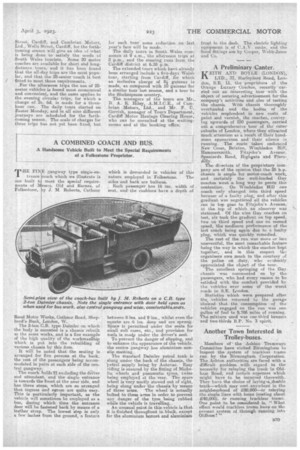A COMBINED COACH AND BUS.
Page 23

If you've noticed an error in this article please click here to report it so we can fix it.
A Handsome Vehicle Built to Meet the Special Requirements of a Folkestone Proprietor.
THE FIN gangway type single-en,
trance nach which we illustrate is one built td meet the special requirements of Messrs. Old and Barnes, of Folkestone, Isy J. M. Roberts, Cathnor
Road Motor Works, Cathnor Road, Shepherd's Bush, London, W.
The 2-ton (lB. type Daimler on which the body is mounted is a chassis rebuilt at the same works, and ia a fine example of the high quality of the workmanghip which is put into the rebuilding of various chassis by this firm.
It will be noted that the seating is arranged for five persons at the back, the rest of the passengers being accommodated in pairs at each side of the central gangway. The Coach holds 21 excluding the tl;liSer and attendant, and the single entrance is towards the front at the near side, and has three steps, which are so arranged that ingress and egress are quite easy. Thin is particularly important, as the vehicle will sometimes be employed as a bus, during which time the entrance door will be fastened back by means of a leather strap. The lowest step is only a few inches from the ground, a feature which is demanded in vehicles of this nature employed in Folkeatone. The sides and baek are bulbous.
Each passenger has 16 ins, width of Seat, and the cushions have a depth of
between 8 iris. and Sins., whilst even the squabs are 6 iris, deep and are sprung. Space is permitted under the seats-, for small suit cases, etc., and provision for tools is matte under the driver's seat. To prevent the danger of slipping, and to enhance the appearance of the vehicle, the centre gangway, has aluminium-nonslip matting.
The standard Daimler petrol tank is slung under the back of the chassis, the 'patrol supply being by Autovae. Easy riding is ensured by the fitting of .Michelin wheels and Pneumatic tyres, twins being employed at the rear. The spare wheel is very neatly stowed out of sight, being slung under the chassis by means of three arms. The wheel is actually bolted to these arms in order to prevent, any danger of the tyre being' rubbed while the vehicle is travelling..
An unusual point in this. vehicle is that it is finished throughout in.blaak, except. for the aluminium bonnet and aluminium front to the dash. The electric lighting equipment is, of C.A.V. make,. and the hood fittings are by Cooper, Webb-Jones and Co.
A Preliminary 'Canter. A Preliminary 'Canter.
KEITH. ANT) BOYLE (LONDON), LTD., 37, Harleyford Road, London, S.E. 11, the proprietors of the Orange Luxury Coaches, recently carried out an interesting tour with the object of securing advertisement for the company's activities and also of testing the chassis. With chassis thoroughly overhauled and the bodies of the vehicles resplendent in new coats of paint and varnish, the coaches, enaNeying upwards of 2-50 passengers, carried otit a comprehensive tour of the outer suburbs of London, where they attracted much attention as a result of their handsome appearance and their. silence in running. The route taken embraced New Cross, Brixton, Wimbledon Hill, Hammersmith, Fitajohn's Avenue Spaniards Road, Highgate and Piccadilly.
The directors of the proprietary company are of the opinion that the 25 b.p. chassis is ample for motor-coach work, and certainly the well-loaded Guy coaches went a long way to prove this contention. On Wimbledon Hill one coach only changed into third speed because of a faulty plug, and after this gradient was negotiated all the vehicles ran in top gear to Fitajobn's Avenue, at the top of which an observer was stationed. Of the nine Guy coaches on test, six took the gradient on top speed, twe on third speed and one on second speed, the mediocre Performance of tho last ea-Salt being again due to a faulty plug, which was quickly remedied. The rest of the ran was snore or less uneventful, the most remarkable feature being the way in which the coaches kept together, and in this respect tha organizers owe much to the courtesy of the police on duty, who etoelently appreciated the object of the tour.
The excellent springing of the Guy chassis was commented on by the passengers, who had every reason to be satisfied with the comfort provided by I to vehicles over some of the worst roads in SE. London.
Statistics which were prepared after the vehicles returned to the garage showed that the consumption of the vehicles engaged on the ran was one gallon of fuel to 8.786 miles of running. The mixture used was one-third benaole and two-thirds B.P. No. 3 spirit,
Another Town Interested in Trolley-buses.
Members of the AshtonTramways Committee have visited Birmingham to inspect the system of trackless trianis ran by the Birmingham Corporation. The Ashton authorities are faced with a difficult problem with regard to the necessity for relaying the trackin Oldham Road,. and certain expenses whirls might have to be incurred therewith. They have the choice of lavingiaadouble track—which may coat anywhere in the neighbourhood of 80,000—or relaying the single lines with loops (costing about
40,001.1), 6r running trackless trams. One point to be considered is, " What effect would trackless teams have. on the present system of through running into Oldham!"
































